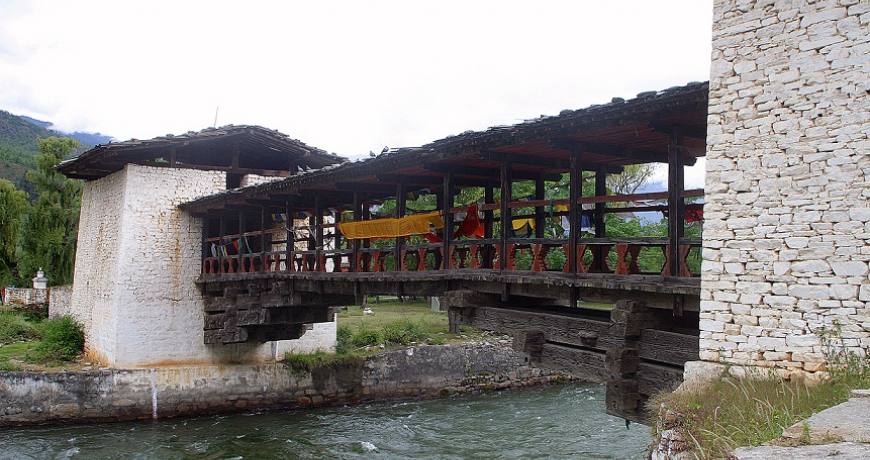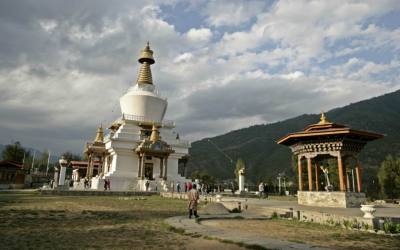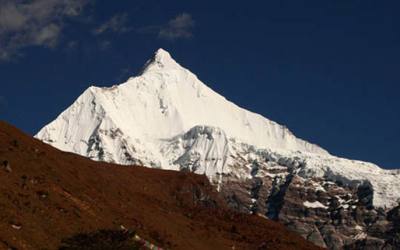The Buddhist Kingdom of Bhutan lies along the lofty ridges of the eastern Himalayas, bordered by China (Tibet) to the north and northwest, and by the Indian states of Arunachal Pradesh, Assam, West Bengal and Sikkim on the east, south and west respectively. With an area of 46,500 square km Bhutan is comparable to Switzerland both in its size and topography.
It was the mighty Himalayas, which protected Bhutan from the rest of the world, and left the Kingdom blissfully untouched. Bhutanese people are driven by their respect for the tantric strain of Mahayana Buddhism.. The Bhutanese people have been able to protect this sacred heritage and unique identity for centuries by choosing to remain shrouded in a jealously guarded isolation.
The population of the kingdom is only about 600,000. Three main ethnic groups constitute Bhutan’s population; the Sharchops, who are held to be earliest resident
Day01: Arrival and transfer to hotel in Kathmandu
Day02: sight seeing around kathmandu valley with English speaking culture guide and by private transport.
Day03: By air to Paro airport in Bhutan and over night at Timpu ( capital of Bhutan)
Day04: sight seeing around Timpu with English speaking guide and by private car
Day05:Timpu-Punaka-Wangdi ( 72k.m. and 3 hrs of driving)
Day06: Punakha to Paro
Day07: By air to Kathmandu and sight seeing around kathmandu valley
Day08: Sight seeing tour to Bhaktapur city by private transport with English speaking guide
Day09: Tour Ends
Kathmandu and Bhutan
Day01: Arrival and transfer to Hotel in Kathmandu
Upon arrival in Kathmandu. Our airport representative will be waiting outside the airport terminal a few metres from the exit door. Please check your name at play card. He will bring you to hotel in kathmandu. The drive from the airport to the hotel is around 20 minutes.
Day02: Free day in Kathmandu or sightseeing around kathmandu valley with English speaking guide.
Hanumandhoka ( Kathamdnu Durbar Square ):
It is the historic seat of royalty. The Durbar Square , with its old temples and palaces, epitomizes the religious and cultural life of people. It is here that kings of Nepal are crowned and their coronations solemnized. Interesting things to see here are, Taleju temple built by king Mahendra Malla in 1954 AD, the temple of Kal Bhairab , the god of destruction, Nautale durbar, the statue of King Pratap Malla, the big drum and the Jaganath temple. It was listed in the UNESCO world heritage monument list in 1979.
On the right hand corner, a large wooden lattice screen hides an enormous gilded face of Sweta Bhairab. The screen is removed only during the Indra Jatra festival.. there are also the Numismatic museum and Tribhuban museum inside the Hanuman Dhoka palace building . Photography is prohibited inside the museums. Both the mseums remain closed on Tuesday and government holidays.
Swoyambhunath ( Monkey temple)
This is one of the world’s most glorious Buddhist Chaityas. It is said to be 2,000 years old. Painted on the four sides of the spire’s base are the all seeing eyes of Lord Budhha. It is 3Km west of Kathmandu city and it situated on a hillock about 77 m commands an excellent view of the Valley. This stupa is the oldest of its kind in Nepal . It was listed in the UNSCO world Heritage Monument List in 1979.
Boudhanath stupa
Boudhanath Stupa (or Bodnath Stupa) is the largest stupa in Nepal and the holiest Tibetan Buddhist temple outside Tibet . It is the center of Tibetan culture in Kathmandu and rich in Buddhist symbolism. The stupa is located in the town of Boudha , on the eastern outskirts of Kathmandu .
History
Bodnath was probably built in the 14th century after the Mughal invasions; various interesting legends are told regarding the reasons for its construction. After the arrival of thousands of Tibetans following the 1959 Chinese invasion, the temple has become one of the most important centers of Tibetan Buddhism. Today it remains an important place of pilgrimage and meditation for Tibetan Buddhists and local Nepalis, as well as a popular tourist site.
Pashupatinath Temple : Situated 5km east of kathamandu, the temple of Lord Shiva , Pashupatinath, with two tired golden roof and silver door is considered one of the holiest for Hindus. Although only Hindus are allowed inside the temple, visitors can clearly see the temple and the activites performed in the Temple premises from the eastern bank of the Bagmati river. The Temple was listed in the UNESCO world heritage Monument List in 1979
Day03: Arrival at Paro airport. You will be received by the airport representative of our Bhutan agent. He will be holding play card with your name at arrival hall. Than drive to Thmpu ( capital of Bhutan). Over night at hotel.
Day04: After breakfast you will have sightseeing tour to different places of Thimpu. Such as visiting to Tashi ChhoDzong ( Fortress of the Glorious religion). Visit to national library which hold the vast collection of ancient Buddhist manuscripts, followed by visiting to painting school. Famous for carving and free hand art. After lunch visit to Memoril chhorten, a monument dedicated to the third king of Bhutan. His late majesty king Jigme Dorjee Wangchuk. Than visit Handicrafts emporium to see the exquisite artistry of traditional crafts and textiles. Evening free for shopping and leisure. Dinner and over night at hotel in Thimpu.
Day05: Timpu-Punaka-Wangdi ( 72k.m. and 3 hrs of driving)
After breakfast drive to Punkha via Dochula pass. It the weather is clear we stop a while at Dochulz pass to view higher Himalayas. While in Punakha visit Punakha Dzong built in 1637 by shabdrung Ngawang Namgyal and is situated between Phu Chu ( Male river) and Mo Chu ( Female river) After lunch drive to Wangdi Phodrang. Along the route we will stop a while to view Chhimi Lhakhang, also called the temple of fertility which is built by Lama Drukpa Kuenley in the 15th century. Along the route sight seeing in the valley of Wangdiphodrang. Which includes visit to Wangdiphodrang Dzong ( from outsite) built in 1638. over night at hotel.
Day06:Punakha to Paro
After breakfast drive to paro. On the way visit Simtokha Dzong built in 1627. after lunch visit Ta Dzong( an ancient watch tower) than to national museum of Bhutan and to Rimpung Dzong ( paro Dzong) built in 1646. at the evening visiting to Drukgyel Dzong, now in ruins. Than to visit Kyich Lhakhang, one of Bhutan’s oldest and sacred monasteries dating from the introduction of Buddhism in the 8th century. Over night at paro.
Day07: Drive to Paro airport for the connecting flight to Kathmandu. During the afternoon sight seeing around Patan.
Patan
The ancient city of Patan , lying 5 km southwest of kathmandu, is known as the city of fine arts, The city is full of Hindu temples and Buddhist monuments. The diversity of the medieval culture that allowed both Hinduism and Buddhism to flourish has left a rich legacy of impressive sightseeing in this city for today’s visitors.
Patan Durbar Square: Situated in the heart of the city, constitutes the focus of visitor’s attraction. The square is full of ancient palaces, Temple and shrines, noted for their exquisite carvings. The Patan durbar Square consist of three main chowks or countryards, the Central Mul Chowk, Sundari Chowk and Keshar narayan Chowk, The Sundari Chowk holds in its center a masterpiece of stone architecture. The Royal Bath called Tushahity. It was listed in the UNESCO world Heritage Monument list in 1979.
Krishna Mandir:
Built in 1637 AD, the temple of Lord Krishaa holds a commanding position in the palace complex of Patan. It is supposed to be the first specimen of Shikhara style architecture in Nepal . It is the only temple in Nepal having 21 spires and is completely 21 spires and is completely mad of stone.
Day08: Sightseeing tour to Bhaktapur city and Changu Narayan temple
Bhaktapur durbar Squares:
The Golden Gate is the entrance to the main courtyard of the Palace of 55 Windows.Built by King Ranjit Malla. The gate is one of the most beautiful and richly carved specimens of its kind in the entire world. This gate is embellished with deities and monsters with marvelous intricacy. The palace of 55 windows was built in 1700 AD. Among the brick walls in their gracious setting and sculptural design, is a balcony of 55 windows. This balcony is a masterpiece of wood carving. The stone temple of Batsala Devi which is also located in the Durbar Square is full of intricate carvings. This temple also sets a beautiful example of Shikhara style architecture in Nepal. There is a bronze bell on the terrace of the temple which is also known as the Bell of Barking Dogs.
This colossal bell, placed in 1737 AD, was rung to signal curfew those days.
The main square of the city contains innumerable temples and other architectural showpieces like the Lion Gate, the statue of King Bhupatindra Malla, the Picture Galley, the Batsal Temple, etc. A magnificent statue of King Bhupatindra Malla in the act of worship is placed on the column facing the palace. It was listed in the UNESCO World Heritage Monument list in 1979.
Changu Narayan: Situated at the end of a long ridge which runs well into the Valley, It is said to have been built by king Hari Dutta in 323 AD said to be the oldest temple in the valley. It was listed in the UNESCO world Heritage Mountain list in 1979
Day09: Tour Ends ( Departure onwards)


